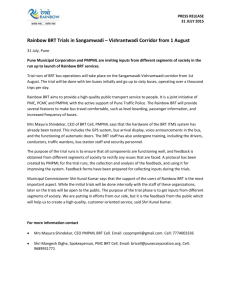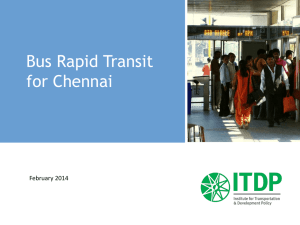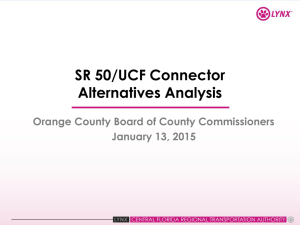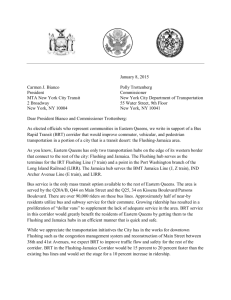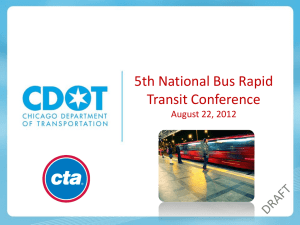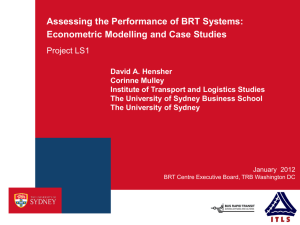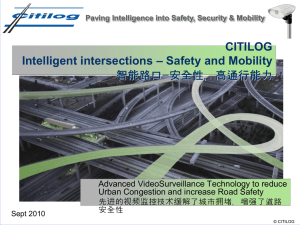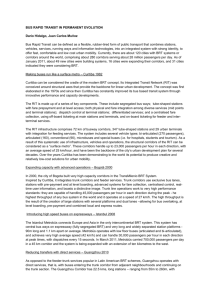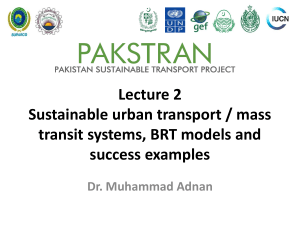Development of Bus Rapid Transit (BRT) in Africa
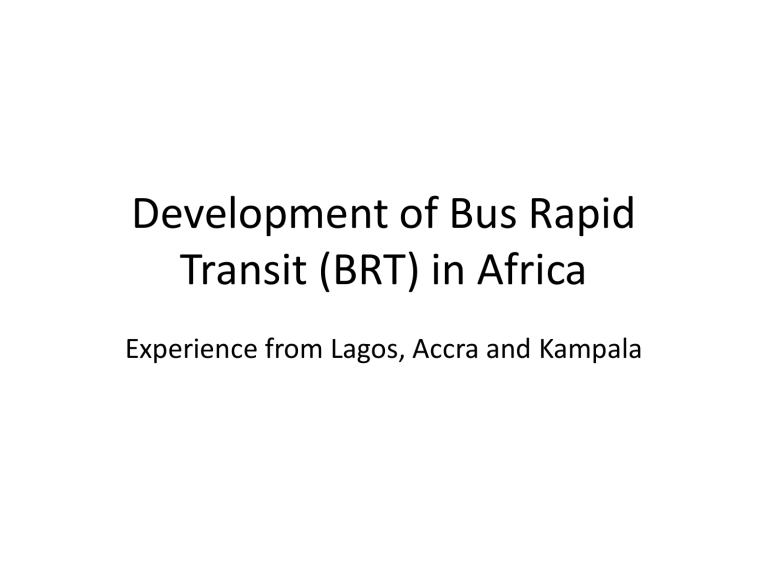
Development of Bus Rapid
Transit (BRT) in Africa
Experience from Lagos, Accra and Kampala
A new approach for Africa
• Latin America is not the only model
• In Sub-Saharan Africa, generally
– Cities are smaller, and lower density (not Lagos)
– Travel demand is dispersed, not trunk focused
– Motorisation is lower, but more minibuses
– Affordability for investment and fares is lower
– Urban environment is more constrained
• A holistic and pragmatic response is needed
Redefinition of BRT
• BRT is a systems-based approach to urban bus provision to meet locally defined user needs within the physical, institutional and financial constraints of an area
• It is a flexible, adaptable and cost-effective means of urban transport based on the bus mode, raising travel speed (absolute and relative), and carrying high volumes of people
BRT Network Concepts
• Base on quantified demand from surveys
• Justified at 6,000 passengers per peak hour
• Integrated tributary for 1,000 passengers/hour
• Develop service plan before infrastructure
• Insertion possible within 30m Right of Way
• City-centre access and terminal arrangements are crucial and difficult
• Costs likely to be $5m to $8m per kilometre, excluding land take and major structures
Public / Private Partnership
• Public sector provides enabling framework: necessary infrastructure, regulatory security, potential of attractive investment returns
• Private sector invests in rolling stock and operates the specified bus services
• Private sector manages the BRT system, and its customer-facing services
• Public sector compensates for displacement
Institutional Framework (1)
• BRT System Owner / Developer
– All strategic decisions: network; routes; levels of service; fares structure; fares levels; selection of operators / managers; form of contract
– Ultimate beneficiary but overall responsibility
• BRT Asset Manager
– Holds and maintains all public BRT assets
– Rewarded for their sustainable availability from user charges
Institutional Framework (2)
• BRT System Manager
– Contracted by, and accountable to, system owner
– Management / supervision of: bus operations; terminals and stations; customer-facing services; quality control and corrective actions; marketing and promotion
– Skills need to be developed / rewarded
• BRT Bus Operations
– Management of delivery to specified standards
Regulatory framework
• Public ownership of the route network and the right to operate bus services over this
• Controlled competition for operating rights of services specified by public institution
• Operators willing and able to enter into contractual relationships for these services
• Monitoring and enforcement capability in the public sector
Strategic Choices
• Form of Service Contract
• Fares structure
• Revenue collection modalities
• Passenger access standards
• Bus specification and size
• Cost recovery
• Fares levels
Form of Service Contract
• Gross-cost contract places revenue risk with public sector; operator is paid only for delivery of the specified service offer
• Net-cost contract requires operators to collect and protect revenues; contract can require track access payment or offer subsidy
• Gross-cost lacks performance incentives, and revenue risk may not be supportable; net-cost contracting preferred by default
Fares and Revenue Collection
• Graduated fares for financial sustainability
• Zonal structure for simplicity / integration
• Pre-paid tickets need closed stations with fares verification on alighting
• On-board payment allows open stations with over-riding control by conductor
• Smart-cards validated / decremented on bus
• Cash alternative payment mode still needed
Station and Bus Specifications
• Passenger access designed for 95+% of people
• Alternative provision for wheel-chair users
• Low station platforms to allow bus clearance
• 2-step bus entry to saloon floor at 850mm
• Optimum bus length 13.7m where allowed
• Articulated buses offer no unit-cost savings, present operational difficulties, and only carry more standing passengers
Cost Recovery and Fares Levels
• Passengers should pay all direct operating and recurrent costs of the BRT system, including maintenance of its infrastructure, but not for the original infrastructure capital investment
• BRT fares should be no higher than those now ordinarily being charged on its routes
• Passenger benefit comes from faster trips, and more reliable / predictable service
Operator Involvement
• Must be treated as partners, and be involved
• Fears of displacement are genuine, and losers have to be compensated
• Industry structure and incentives not suited to formal bus operation; development needed
• Mobilisation of necessary finance for fleet requirement is a real challenge
• Vision offered must be attractive and honest
Popular and Political Support
• Identify a credible political Champion
• Public relations and information strategy to build expectation and ownership
• Recognise that this doesn’t finish at system launch – continuous improvement
• Watch the electoral cycle – BRT can be implemented within one term, but real difficulties if it isn’t
Conclusion
• This approach might be termed BRT Lite, but
Lagos has shown that it can do the heavy lifting!
• The lower the cost, and the greater the return, the more likely the system can be expanded
• All of the features of the enabling framework can be replicated on the core route network in a city, and enable new large-bus operation
